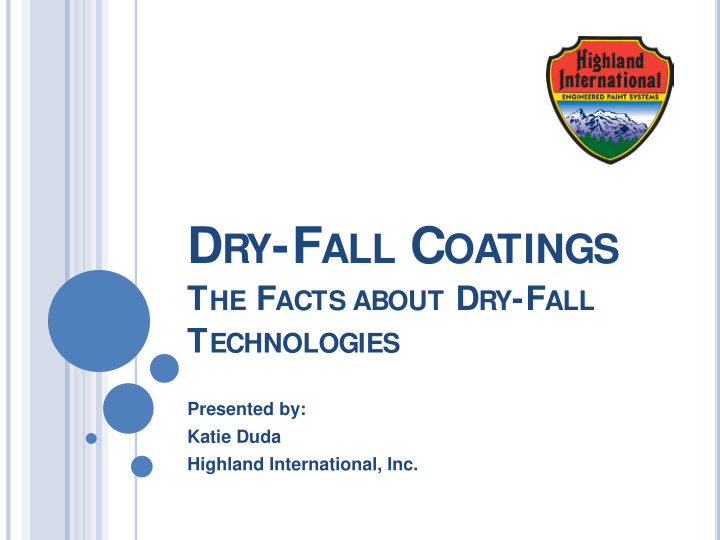



D RY -F ALL C OATINGS T HE F ACTS ABOUT D RY -F ALL T ECHNOLOGIES Presented by: Katie Duda Highland International, Inc.
O UT L INE What is a Dry-Fall Coating Why Use Dry-Fall Coatings - Overspray and Liabilities - Labor Savings Evolution of Dry-Fall Coatings - Interior vs. Exterior - Waterborne vs. Solventborne - Pros & Cons - Types of Dry-Fall Coatings Available Today How to Evaluate Exterior Dry-Fall Coatings Where are Dry-Fall Coatings being Used Open Discussion
W HAT IS A D RY -F ALL C OATING ? A coat ating, when spray ap ay applied, i , is powder d dry ry in in a as s lit little as s 8-10 f 0 feet from om the the poi point of of appl pplication. Also known as: Dry-Fog Coatings Spray-Safe Coatings
W HY U SE D RY -F ALL C OATINGS ? Eliminate Overspray Worries in Congested Areas Can be approved to use in no-spray zones Avoids costly encapsulation Alternative to Brushing & Rolling OVERSPRAY
O VERSPRAY C LAIMS C AN B E C OSTLY Overspray can damage nearby cars, equipment and can also be a hazard to the environment.
I S O VERSPRAY A CONCERN ? YES
W HY U SE D RY -F ALL C OATINGS ? Decrease Labor Costs (at least 4X faster than brushing and rolling) Extend Maintenance Budgets Complete Coating Repairs more Quickly- Less Down-Time
T HE HE E VOL OLUTION OF OF D RY -F AL ALL C OATIN INGS Originally formulated for interior applications, Dry-Fall or Spray-Safe technology was developed to offer a fast-dry/ less-mess solution for residential and commercial uses. These formulas were traditionally offered in a flat finish only. Over the years, formulas were adapted to move interior solutions to exterior solutions in both water-borne and solvent-borne options.
W ATER ER - BOR NE VS . . S OLVENT - BOR NE ORNE ORNE • Water Soluble (solutions) Water-borne • Water Dispersible Coatings (Dispersions) • Emulsions (Latex) • Standard Solvent-borne • Low VOC/ VOC Exempt Coatings • High Solids
W ATER -B ORNE C OATINGS : PROS & C ONS Pros Pro Cons ns Usually lower solids/ Can reduce VOC and hard to control film HAP emmissions* thickness/ runs & sags Good storage life Flow properties and Easy to clean up dry times change with humidity Low odor Can promote flash Dried paint may be rusting when used as a disposed of in a a primer landfill as non Longer dry times hazardous waste Reduced temperature * Not all waterborne coatings • resistance have lower VOC or HAPs ratings
S OLVENT -B ORNE C OATINGS : P ROS & C ONS Pros Pro Cons ns Available in low VOC Can be more difficult and HAP ratings* to repair Reduces number of 2-K products may spray applications to have shorter pot life achieve target DFT Harder to clean up Improves abrasion Can have higher VOC and mar resistance content More surface tolerant Decreased flexibility Better adhesion/weatherabi in application equip. lity
T YPES OF E XTERIOR D RY -F ALL C OATINGS A VAILABLE T ODAY : Alkyds Acrylics Epoxies Urethanes Zincs Silicones Hybrids/ Copolymers
UATE E XTERI ERIOR H OW TO E VAL UA D RY -F ALL LL C OATIN INGS : How do they measure up to your “go-to” standard coatings of the same vehicle type? Compare: - Adhesion (Elcometer or Crosshatch) - Salt Spray Results (note hours) - Weatherability/ QUV - Thermal Shock (for high temperature)
Typical Applications Cranes/Tall Storage Piping and Sructures Tanks Pipe Racks and more
Typical Applications (Continued) High Near Complex Temperature Waterways Structures and more
P ROJECT P ROFILE : S TORAGE T ANK , V ICOTRIA TX The storage tank at this terminal was successfully coated with a Dry-Fall organic zinc primer, epoxy mid-coat, and urethane topcoat only 100 feet from a car dealership!
C ONCLUSIONS Every coating has advantages and disadvantages……but knowing how to best evaluate your own situation will help you best chose the correct system for your specific needs. QUESTIONS?